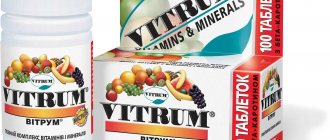Vitamin A is a collective concept for a number of compounds that are similar in structure. These include: retinol, retinal, retinoic acid, deroretinol.
Retinol is the true vitamin A, found in animal foods, while its precursor, carotene, is found in plant foods. The daily requirement for men is 900 mcg, for women - 700 mcg, and in pregnant women it is higher. It is worth considering that its excess intake is fraught with hypervitaminosis, accompanied by symptoms of intoxication. The maximum safe dose for adults is 2500–3000 mcg per day.
Role in the body
Among the biological functions it is worth noting:
- participates in the synthesis of enzymes necessary for the formation of mucopolysaccharides, hyaluronic acid, heparin, taurine;
- participates in the synthesis of liver enzymes;
- promotes the production of somatomedins, which are responsible for the formation of muscle proteins, nucleic acids, and collagen;
- is a structural component of cell membranes;
- participates in the synthesis of sex hormones and immune factors;
- responsible for the growth, reproduction and differentiation of epithelial tissues, prevents their keratinization;
- participates in vitamin D metabolism;
- is a key component in the synthesis of rhodopsin, a pigment necessary for twilight vision.
Forms of Vitamin A
There are 3 forms of vitamin A:
- retinols (the most active form, mainly found in foods of animal origin);
- beta-carotenes (plant sources of the vitamin);
- carotenoids (exist in free alcohol or in fatty acyl ester form, the most numerous group).
The pharmacological form of release is also different:
- dragee;
- drops for internal use;
- oil solution;
- capsules;
- film-coated tablets;
- injection.
Biological role
Vitamin A affects the barrier function of the skin, mucous membranes, the permeability of cell membranes and the biosynthesis of their components. The effect of vitamin A in these cases is associated with its involvement in protein synthesis.
Currently, the importance of vitamin A in the process of photoreception has been clarified in more detail.
The retina of most vertebrates contains two photoreceptor systems: the rod apparatus, sensitive to low light intensity, i.e. twilight vision and cone vision - adapted to high light intensity and for color vision. Photosensitive pigments, called rhodopsin, are chromoproteins consisting of a chromophore group - vitamin A-aldehyde (retinal) and a protein - opsin. The cone photoreceptor systems (iodopsin and cyanopsin) consist of the same chromophore groups connected to a protein that is structurally different from opsin. In the light, rhodopsin is broken down into the protein opsin and retinal; the latter transforms into a trans form; These transformations are associated with the transformation of the energy of light rays into visual stimulation. In the dark, the reverse process occurs - the synthesis of rhodopsin, which requires the presence of an active form of aldehyde - 11-cis-retinal, which can be synthesized from cis-retinol or trans-retinal, or the trans form of vitamin A with the participation of specific dehydrogenases and isomerase.
Under the influence of a quantum of light, rhodopsin, through a series of intermediate products (“orange” and “yellow” proteins), breaks down into opsin and allo-trans-retinal, which is an inactive form of vitamin A aldehyde. Allo-trans-retinal can be partially converted into active 11-cis -retinal under the influence of light (dotted arrow in the diagram). However, the main route of formation of 11-cis-retinal is the enzymatic conversion of the trans form of vitamin A into the cis form (under the action of isomerase), and its subsequent oxidation with the participation of alcohol dehydrogenase.
Beneficial features
Each vitamin has its own function in the body. Retinol has several of them.
- It has a positive effect on the functioning of the visual organs. This is a means of preventing senile blindness.
- Vitamin A is essential for maintaining the integrity and function of skin cells, as well as the respiratory and digestive systems.
- Retinol plays an important role in the development of lymphocytes (white blood cells). They are key agents in the immune system response.
- Prescribed for pregnant women: participates in the growth of limbs, the formation of the baby’s heart, eyes and ears. Also responsible for growth hormone: a deficiency can provoke a birth defect.
- Considered a strong antioxidant. It has the ability to neutralize free radicals that lead to the development of chronic diseases (for example, diabetes).
- Retinol is the key to healthy bones. With enough of it, the risk of fractures is reduced by 6%.
Clinical trial results
Visual symptoms
Characteristic symptoms of vitamin A deficiency in humans are eye lesions, including disorders of the retina, conjunctiva and cornea. The twilight vision disorder, known as night blindness, or hemeralopia, which deprives a person of orientation in space and the ability to move in the dark at dusk, is one of the early manifestations of vitamin A deficiency. Much later, the disorder of night vision is accompanied by lesions of the conjunctiva and cornea. The weakening of dark adaptation is associated with a decrease in the supply of vitamin A in the form of vitamin A-aldehyde to the retinal rods. Weakening of night vision long before the development of subjective manifestations of hemeralopia can be detected by scotometry, dark adaptation studies and electroretinography.
Morphological changes in the eye with vitamin A deficiency appear later than dark adaptation disorders. They arise as a result of keratinization of the epithelium of the conjunctiva, cornea and cessation of secretion of the lacrimal glands, which together leads to the development of xerosis. To more accurately describe the eye condition specific to vitamin A deficiency, it is recommended to use the narrower terms “conjunctival xerosis” and “corneal xerosis.” Conjunctival xerosis appears as one or more patches of dry, non-wetting conjunctiva. The spots are best seen in side lighting. Typical xerosis may be accompanied by varying degrees of thickening of the conjunctiva, its wrinkling and pigmentation. There is a decrease in the sensitivity of the bulbar conjunctiva, photophobia, and a feeling of the presence of a foreign body in the eye (“sand sensation”). Along with general changes in the conjunctiva, limited xerotonic changes can be observed on it - Bitot's plaques located on the conjunctiva of the sclera.
In older children, adolescents and adults, eye changes are limited to xerosis. In contrast, in infants and children under 4 years of age, eye changes due to vitamin A deficiency often extend to the cornea. Damage to the cornea begins with xerosis, decreased sensitivity and progressive opacification. Subsequently, keratomalacia develops, passing into the stage of infiltration, ulceration, softening and perforation. Keratomalacia often results in complete or partial loss of vision.
Application in medicine
For each disease, a different vitamin A derivative and corresponding dosage are prescribed. Before starting treatment, it is important to consult a specialist and take tests to determine the level of vitamin A in the body. Your doctor may prescribe retinol in the following cases:
- protein deficiency;
- overactive thyroid gland;
- cataract;
- recent laser eye surgery (healing occurs faster);
- retinal damage (eye diseases progress more slowly);
- malaria;
- complications during or after pregnancy (especially if a woman is not able to eat properly);
- peeling and rashes on the skin.
The effect of hypovitaminosis on other organs
One of the clinical manifestations of vitamin A deficiency is skin changes known as follicular hyperkeratosis. The initial sign of skin changes is dryness and roughness of the skin, caused by increased keratinization of the surface epithelium and suppression of the activity of the sweat and sebaceous glands. Subsequently, skin changes occur according to the type of follicular hyperkeratosis and dryness is replaced by a papular rash. The rash occurs on the outer and lateral surfaces of the thighs, the back and lateral surfaces of the forearms, spreading further to the rest of the body.
In addition to the characteristic symptoms of vitamin A deficiency in humans and animals, symptoms such as growth inhibition, loss of body weight, and general exhaustion of the body also appear.
In scientific research
Science never stands still. For example, many diseases that were once considered deadly can now be successfully treated. Vitamins are part of almost all enzymes and, together with them, are accelerators of metabolic processes. Research on the importance of the role of vitamins in human life does not stop for a minute.
- Scientists from Sweden have discovered the effect of vitamin A on human embryonic development. Retinol is involved in the formation of blood cells and helps form different types of tissue in the growing fetus.
- Researchers at Case Western Reserve University have found that uncontrolled vitamin A metabolism in the gut can trigger severe inflammation.
- Retinol increases the activity of cells responsible for producing insulin. Beta cells have a huge number of receptors sensitive to vitamin A.
Should I take vitamin E supplements?
If a person eats more or less normally, he needs 4 years of extreme diet to use up all the vitamin E reserves in the liver. Therefore, tocopherol deficiency is rare. It usually appears if a person has impaired lipid absorption.
“Without fats, normal absorption of vitamin E is impossible, so it is important to include oils in your daily diet,” explains Nadezhda Nabatnikova. — Wheat germ oil, sunflower oil, safflower oil and soybean oil are rich in vitamin E. Nuts such as almonds and peanuts are also suitable sources.”
Only your doctor can decide whether you should take vitamin E supplements. If you self-medicate and drink “for health”, you can get hypervitaminosis. It is manifested by nausea, vomiting, weakness, headache and blurred vision. Particularly persistent ones lead themselves to disorders of the blood coagulation system.
In cosmetology
Cosmetologists say: retinol is the gold standard in skin care. This is practically a magician who solves all problems (from acne to wrinkles). The positive effect is observed in the following:
- increased elastin production;
- stimulating the formation of new blood vessels;
- decreased activity of the sebaceous glands;
- reduction of sebum secretions;
- provoking the exfoliation of dead cells (a means of preventing clogging of pores).
Vitamin A source foods
Vitamins serve as catalysts and regulators of biochemical reactions. If you need vitamin A, you should definitely have the following products in your refrigerator.
- Carrot. The vegetable is rich in beta-carotene, which is converted into vitamin A in the body. Absorption occurs only together with fats: carrots are consumed with sour cream, cream or butter.
- Cod liver. Contains a large amount of fish oil, which are healthy Omega-3 fatty acids that help absorb vitamins.
- Spinach. Called the "king of greens." It is the leader among vegetables not only in terms of vitamin content, but also vegetable proteins and fiber.
- Avocado. In addition to all kinds of vitamins, the fruit is rich in monounsaturated fats that are easily absorbed by the body. At the same time, it gives you a feeling of satiety for a long time.
- Vegetable oil. In oils, vitamin A is present in the form of its precursors from a fairly large family of carotenoids. They color plant tissues yellow or orange.
- Butter. Contains about 80% fat and 4 hundred different fatty acids, without which the normal functioning and growth of the body becomes impossible.
Vitamin A (Retinol)
vitamin A, of course.
– that it is contained in carrots and is extremely important for vision. And when eating carrot juice, you should wash it down with fresh cream. But is this vitamin A so simple?
Vitamin A (Retinol) was discovered in 1920 by a group of scientists, it is the first vitamin discovered.
Scientists, after much research, came to the conclusion that butter and the yolk of a chicken egg contain a substance associated with lipoids necessary for the growth of animals; they also showed that butter contains an active principle that is not destroyed by the action of alkalis and remains outside during saponification saponified fraction. This substance was designated "fat soluble factor A" and was later renamed vitamin A.
Other names for vitamin A are Anti-infective vitamin, anti-xerophthalmic vitamin, retinol, dehydroretinol.
There are two forms of this vitamin: ready-made vitamin A (retinol) and provitamin A (carotene), which is converted into vitamin A in the human body, so it can be considered a plant form of vitamin A.
It has a pale yellow color that is formed from the red plant pigment beta-carotene. During heat treatment, it almost does not lose its properties (only 15-30%), but in combination with air during long-term storage it is destroyed.
Physicochemical properties of vitamin A
The vitamin A group includes the following compounds: Retinol, Retinal, Retinoic acid, Retinol palmitate, Retinol acetate.
Vitamin A is a cyclic unsaturated alcohol, which, when oxidized in the body, forms vitamin A-aldehyde and retinoic acid.
Food Sources of Vitamin A
Foods rich in vitamin A - carrots, pumpkin, bell peppers, spinach, broccoli, green onions, parsley, peaches, apricots, apples, grapes, watermelon, melon - are plant sources (carotenoids); Animal sources include fish oil and liver (especially beef), followed by butter, egg yolks, cream and whole milk.
Cereal products and skim milk, even with vitamin supplements, are unsatisfactory sources, as is beef, which contains negligible amounts of vitamin A.
Daily requirement for vitamin A
The recommended daily dose of vitamin A is:
- Infants: 0-6 months. – 400 mcg; 7-12 months – 500 mcg
- Children: 1-3 years – 300 mcg; 4-8 years – 400 mcg
- Men: 9-13 years old – 600 mcg; 900 mcg (3000 IU) for 14-70 years
- Women: 9-13 years – 600 mcg; 700 mcg (2300 IU) for 14-70 years
- Pregnant women: under 19 years old – 750 mcg; 19-50 years old – 770 mcg
- Women breastfeeding: under 19 years old – 1200 mcg; 19-50 years old – 1300 mcg
For diseases associated with retinol deficiency, the dosage can be increased to 10,000 IU per day (calorizer). (The above dosages apply exclusively to the retinoid form of vitamin A. The carotenoid form is not as toxic).
Retinol can be obtained from pharmaceutical supplements (which is 1/3 of the daily requirement), and 2/3 of this vitamin can be obtained from natural foods that contain carotene, such as sweet peppers or carrots.
Beneficial properties of vitamin A
Vitamin A (retinol) is a fat-soluble vitamin, an antioxidant, essential for vision and bones, as well as healthy skin, hair and immune system function. Retinol is involved in redox processes, regulation of protein synthesis, promotes normal metabolism, the function of cellular and subcellular membranes, plays an important role in the formation of bones and teeth, as well as fat deposits; necessary for the growth of new cells, slows down the aging process.
Vitamin A fights viruses and bacteria well, helps strengthen nails and speed up wound healing.
It has a good effect on the reproductive system of men and women, increases the activity of the production of sex hormones.
Harmful properties of vitamin A
Vitamin A can be harmful if overdosed. When there is an excess of it, the body is poisoned and manifests itself in the following symptoms: loss of appetite, nausea, headache, inflammation of the cornea, enlarged liver.
Pregnant women should use this vitamin with caution, because An excess of Retinol can lead to developmental disorders of the fetus and the appearance of various congenital pathologies in the child.
Vitamin A absorption
Vitamin A is fat-soluble, so it requires fats as well as minerals to be absorbed by the digestive tract.
Its reserves remain in the body long enough that it does not need to be replenished every day.
Vitamin A deficiency in the body
With a deficiency of vitamin A, night blindness develops, a skin rash appears, the skin peels off, premature aging begins, increased susceptibility to various diseases, visual acuity decreases, dry eyes occur, conjunctivitis develops, dandruff and hair loss appear, and appetite decreases.
Excess vitamin A in the body
With an excess of vitamin A, the following symptoms appear: nausea, vomiting, drowsiness, headache, lethargy, redness of the face, pain in the bones of the lower extremities, menstrual irregularities.
Participation in the vision process of vitamin A
Carotenoids (ie, plant sources of vitamin A) are the main sources of protection for our eyes, they help prevent cataracts, and also reduce the risk of macular degeneration, which is the main cause of blindness.
Participation in the body's antioxidant defense of vitamin A
Vitamin A is an essential component of the body's antioxidant defenses, especially carotenoids. It promotes its interaction with free radicals, including oxygen free radicals - this is the most important feature of the vitamin, which allows it to be considered an effective antioxidant.
The antioxidant effect of vitamin A plays an important role in the prevention of heart and artery diseases, also has a protective effect in patients with angina pectoris, and also increases the content of good cholesterol in the blood (calorie).
Due to the fact that Retinol is considered a powerful antioxidant, it is a means of preventing and treating cancer, and prevents the reappearance of tumors after surgery.
Interaction of vitamin A (Retinol) with other substances
Vitamin A significantly enhances the antioxidant properties of vitamin E, but it can be destroyed completely if there is not enough vitamin E in the body. Also, Retinol is not retained in the body if there is not enough vitamin B4.
Vitamin E (tocopherol) protects vitamin A from oxidation both in the intestines and in tissues. Therefore, if you are deficient in vitamin E, you cannot absorb the required amount of vitamin A and therefore the two vitamins must be taken together.
Zinc deficiency can impair the conversion of vitamin A into its active form. Because the body, in the absence of sufficient zinc, cannot synthesize vitamin A-binding protein—the transport molecule that transports vitamin A through the intestinal wall and releases it into the blood—zinc deficiency can result in poor supply of vitamin A to tissues. These two components are interdependent: thus, vitamin A promotes the absorption of zinc, and zinc also acts in relation to vitamin A.
Mineral oil, which can sometimes be taken as a laxative, can dissolve fat-soluble substances (such as vitamin A and beta-carotene). These vitamins then pass through the intestines without being absorbed because they are dissolved in mineral oil, from which the body cannot extract them. Chronic use of mineral oil can thus lead to vitamin A deficiency.
For normal absorption of Retinol, the presence of fats and proteins in the diet is necessary. The difference between edible oil and mineral oil is that the body can absorb edible fat along with the vitamin A dissolved in it; The body does not absorb mineral oil.
How much vitamin A do you need?
The daily intake of certain micronutrients into the body is necessary for full functioning. The daily requirement of vitamin A varies for different categories of people:
- for children up to six months, 0.4 mg per day is required;
- from six months to three years - 0.6 mg;
- for preschoolers and primary school students, 0.9 mg is required;
- for adolescents - 1.7 mg;
- pregnant and lactating women are prescribed 3 mg;
- men - 2 mg;
- for elderly people, 0.8 mg is sufficient.
The effectiveness of synthetic vitamins
Vitamins in tablets - are there any benefits? Doctors still have not come to a consensus on whether it is worth using synthetic multivitamins in addition to nutrition for preventive purposes.
Proponents of the use of vitamins for the purpose of prevention argue that hypovitaminosis is a constant companion of modern man, which invariably leads to a weakened immune system and the development of many diseases. In their opinion, this is due to the fact that most vitamins are destroyed during heat treatment and long-term storage. The composition of vegetables and fruits is changing as new growing and storage technologies are used, which leads to a significant deterioration in the quality characteristics of food products. The vitamins that enter the body with food are not enough to ensure the full functioning of organs and systems. As a result, you have to compensate for this deficiency with the help of multivitamins.
Adherents of naturally saturating the body with vitamins through a varied and balanced diet believe that taking additional multivitamins is useless and sometimes even harmful.
To study the effect of antioxidants - vitamins A, C, E on people suffering from pathologies of the cardiovascular system, as well as with a high risk of developing cancer, large-scale medical studies were carried out. There was no significant protective effect of synthetic vitamins in preventing heart attacks, strokes or cancer.
Signs of deficiency
Vitamin deficiency is a pathological condition associated with a deficiency of a substance in the body. You can suspect something is wrong based on the following symptoms:
- deterioration of visual acuity;
- dry skin;
- respiratory tract diseases;
- long-term healing of wounds and skin abrasions;
- slow growth (in childhood);
- white spots on the oral mucosa;
- painful perception of bright light;
- dandruff;
- acne.;
- brittle nail plates.
Contraindications and precautions
Consuming excess amounts of vitamin A can be dangerous to your health. With a balanced diet, the daily dose can be easily obtained without the use of specific additives, from ordinary products. For adults, the upper daily limit is 3,000 mcg (10,000 IU). Very high doses can cause severe poisoning and even death.
Overdose symptoms:
- Deterioration of visual function.
- Joint pain, bone pain.
- Lack of desire to eat.
- Nausea and vomiting.
- Photosensitivity.
- Baldness.
- Headache.
- Dry skin.
- Liver damage.
- Yellowing of the skin.
- Stunted growth.
- Dizziness.
- Skin itching.
Excessive amounts of vitamin A are dangerous during pregnancy. Overdose carries a risk to the health of the mother and fetus. There is evidence that hypervitaminosis of vitamin A increases the risk of developing lung cancer in smokers. Therefore, you need to take retinol supplements carefully and strictly follow the dosage.
Signs of severe vitamin A deficiency
Vitamin A deficiency develops if a person consumes few foods containing this substance. Alcoholism and malabsorption aggravate the situation. You can understand that the body is experiencing a lack of vitamin A by the following signs:
- Night blindness. This is the first signal of existing hypovitaminosis.
- Corneal ulcers. With severe vitamin A deficiency, vision can be lost completely.
- Immunodeficiency.
- Frequent respiratory infections. Among children with vitamin deficiency, there is a higher mortality rate from measles.
- Diarrhea.
- Impaired growth and bone formation.
- COPD, pulmonary emphysema. Obstruction most often develops in smokers.
Signs of excess vitamin A
Symptoms of acute vitamin A hypervitaminosis:
- Nausea.
- Headache.
- Decreased performance.
- Loss of appetite.
- Dizziness.
- Dry skin.
- Brain swelling.
Chronic hypervitaminosis of vitamin A can cause the development of osteoporosis, as well as birth defects in the fetus. In this regard, retinol derivatives are especially dangerous, so it is better for pregnant women to be prescribed beta-carotene.
People with an increased risk of lung cancer, smokers, and people whose bodies are exposed to asbestos should not take vitamin A supplements for a long time.
Interaction with other drugs
To support vitality and prevent a number of diseases, many people prefer to use multivitamin complexes. When choosing such drugs, it is important to consider the compatibility of vitamins.
- Vitamin A entering the blood will be destroyed instantly if there is no vitamin E in the body. But the latter should be less than the former.
- With a deficiency of vitamin B4 (choline), vitamin A is not stored for future use.
- Vitamin F enhances the properties of retinol.
- Vitamin D cannot be combined with vitamin A: they neutralize each other’s effects.
- Vitamin B2 increases the healing properties of zinc, and the microelement, in turn, improves the absorption of A.
What is vitamin E
This is a family of tocopherols and tocotrienols - eight antioxidants that protect body cells from free radicals. This is the name given to oxygen atoms that are missing one electron. They strive to take it away from everything they reach, damaging surrounding cells and causing their death. Vitamin E absorbs free radicals, reducing the harmful effects of solar radiation and improving antitumor protection.
Getting into skin cells, it reduces the synthesis of prostaglandins and nitrogen oxides - mediators of inflammation. Its wound healing properties are known. Therefore, vitamin E is used to treat inflammatory skin diseases - psoriasis, atopic dermatitis, ulcers and pustular dermatosis. The anti-inflammatory effectiveness of tocopherol for acne has been proven. A study on mice showed that tocopherol prevented skin cancer, but this did not work in humans.
The magical effects of vitamin E are the result of taking it orally. When used externally, it does not treat wounds, burns and scars - this is what the study showed. But in combination with retinol, phytonadione and vitamin C, it sometimes helps remove circles under the eyes. It is often added to anti-aging creams, but it is not yet clear whether it will help protect skin from aging. But it is known that in some people the external use of this vitamin causes an adverse reaction in the form of contact dermatitis.








